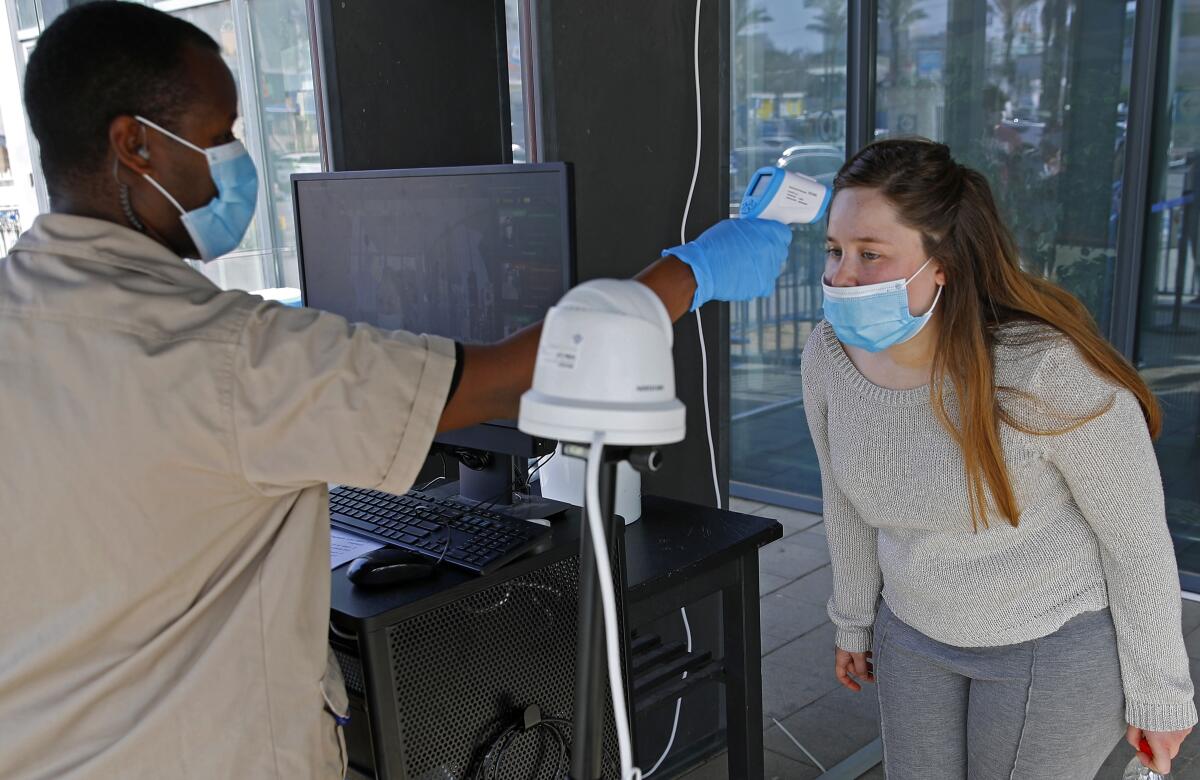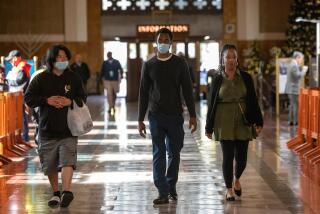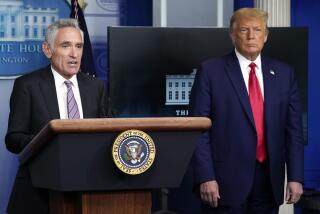Could a ‘controlled avalanche’ stop the coronavirus faster, and with fewer deaths?

- Share via
Could a “controlled avalanche” of deliberate coronavirus infections end this pandemic faster, and with fewer deaths?
In Israel, a country with just a single ski resort, a team of researchers argues that borrowing a trick from alpine mountaineers might be the best way for some countries to fast-forward the outbreak to its logical conclusion: the public health ideal of “herd immunity.”
The strategy would mimic the effects of a vaccination campaign by encouraging a majority of a population to become infected with the coronavirus and recover. But embedded within are a plethora of practical, political and ethical dilemmas, experts warn.

Political leaders will face the charge that they’re sacrificing lives to shore up their economies. Healthcare workers and first responders could be overwhelmed with COVID-19 patients. Low-income workers, already burdened by poorer health, would feel pressured to become infected so they could return to work.
And what if the engineers of this avalanche guessed wrong about when the virus would sputter to a halt? About whether, and for how long, survivors will be immune? About how many will die of an infection that they might, with time, have avoided?
But as the coronavirus’s transcontinental romp approaches its fifth month, leaders and researchers are openly asking whether going for herd immunity the old-fashioned way might be better than waiting for a vaccine. And as some American cities, counties and states reopen for business, they may blunder into the strategy by accident.
That process could get a push from the Israeli study, which surfaced this week on MedRxiv, a website where researchers share their preliminary work.
Matthew Liao, who directs the Center for Bioethics at New York University, said the impulse to find a shortcut out of the pandemic is entirely reasonable.
“But it’s a bad idea,” he said of the proposal from the Israeli researchers. To embrace such a strategy as a way to lessen the population’s economic suffering “is a bit of a false dilemma,” he said. Beside risking lives to engage in a population-wide medical experiment, “there are a lot of other ways to reduce the economic impact” of a prolonged campaign of social distancing, he said.
Economists and experts weigh the difficult trade-off in fighting the coronavirus.
In an actual controlled avalanche, safety experts engineer the periodic release of a mountainside’s buildup of snow to keep the valley below from becoming entombed.
In the coronavirus version, the Israeli researchers propose to recruit waves of healthy volunteers in their 20s, 30s and 40s who are willing to be deliberately infected. In numbers that never exceed Israel’s healthcare capacity, the volunteers would weather any symptoms, recover, and rejoin a growing population of immune compatriots. The rest of the country would remain locked down.
If 80% of eligible Israelis sign up to be infected, virtually all of these “controlled avalanche” graduates would join the ranks of those who recovered from unintentional infections, the authors calculate. Applying age-specific death rates tallied in Wuhan, China, to Israel’s population, the team estimated that 2,540 of those volunteers would die from COVID-19. But within roughly 200 days, they say, somewhere between 40% and 71% of Israel’s population of 8.9 million would gain immunity from the virus the old-fashioned way.
At that point, the coronavirus would run up against so many immune Israelis that its spread would virtually stop. This collective state of herd immunity would protect those, including the old and vulnerable, who had stayed at home as the controlled avalanches tumbled down outside.
Compared to a strategy in which all Israelis are urged to stay inside and practice social distancing, the controlled avalanche strategy would reduce overall deaths by 43%, the researchers calculate. The benefits of herd immunity after the lockdown ends would save the lives of Israelis who are more vulnerable to the virus. And that point would come faster, cutting deaths further.
Cumulatively, implementing a controlled avalanche strategy would drive down the maximum number of people who need intensive hospital care by 62%, the study authors said. And half of the people at low risk of becoming ill could leave their homes and go back to work two months earlier.
“Implementation of the controlled avalanche policy is thus the safest among all the possible options,” the authors conclude.
You’ve heard the term “herd immunity.” Here’s what it means and why it’s important as we think about returning to something like a normal life.
Johns Hopkins University bioethicist Jeffrey Kahn said the new research is problematic because it relies on facts about the virus’ behavior and impact that are still in dispute.
The idea that those between 20 and 49 would die of COVID-19 in such small numbers has been countered by later studies and by many case reports, Kahn said.
So has the belief that reinfection doesn’t happen after a person has recovered. One study released this week suggested that as many as 30% of those who have recovered produce very low levels of protective antibodies, and in 10% of cases the levels were too low to be detectable, calling their immunity into question.
The World Health Organization went further in a scientific brief released Friday. Pushing back against proposals by some countries to issue “immunity passports” to those who have recovered, the WHO warned that even people with coronavirus antibodies may be vulnerable to a second infection.
Researchers are a long way from having the data in hand to pinpoint the level of population immunity necessary for the pandemic to fizzle, Kahn added.
“A lot of basic immunology stuff still has to be worked out,” he said. “Until you know those answers, you can’t analyze the risk-benefit balance” to inform prospective participants. “And if you can’t offer that, you can’t justify” the experiment.
And make no mistake, he added, at this point it would be an experiment.
About four months after the coronavirus was first identified in China, wider testing has begun to reveal that, in California and many other places, it has already infected many more than were known. Those who have mild or no symptoms now account for at least 25%, and in some populations as many as 70%, of the infected.
As a result, assessments of the virus’ ability to kill — the case-fatality rate — have been adjusted steadily downward. Not only does the ideal of herd immunity seem closer than believed; the cost in lives of achieving that goal may appear lower.
Even before those trends came to light, the race to gain herd immunity looked appealing enough that British Prime Minister Boris Johnson thought it was worth a try.
In early March, with a vaccine estimated to be at least 18 months away, U.K. officials reasoned that once roughly 60% of Britons had recovered and gained immunity to the coronavirus, its spread would slow to a crawl. The extremely vulnerable and the as-yet-uninfected would be safe. And the United Kingdom could go back to work.
When a distinguished group of British academics projected in mid-March that such an experiment would kill at least half a million Britons and overwhelm the country’s healthcare system, the idea lost its allure.
A study of COVID-19 patients and the people they likely infected suggests the coronavirus can spread for more than two days before symptoms appear.
Sweden, meanwhile, is moving ahead with the strategy. The Nordic country has ordered no lockdowns and no closures of workplaces, schools or restaurants. Its leaders are explicitly counting on its citizens to decide how willing they are to become infected and who needs the protection of isolation, and to act accordingly.
Dr. Anders Tegnell, chief epidemiologist at Sweden’s Public Health Agency and the architect of the country’s coronavirus response, told the journal Nature that “each country has to reach ‘herd immunity’ in one way or another, and we are going to reach it in a different way.”
This week, Tegnell reported that with 20% of Stockholm’s population already infected, “we’re already seeing the effect of herd immunity.” He predicted the virus would slow further in the coming weeks as it ran out of densely packed city dwellers to infect. In the rest of the country, where the population is more diffuse, “the situation is stable,” he said.
Meanwhile, another group of researchers has projected that if India were to allow its citizens to become infected under controlled circumstances, an estimated 60% of them would emerge with immunity by November. That would be sufficient to deny the virus the pool of potential infectees it needs to thrive, according to a group from Princeton University and the Center for Disease Dynamics, Economics and Policy, a public health advocacy group based in New Delhi and Washington.
Because of India’s disproportionately youthful population, deaths and hospitalizations would be low if it allowed a degree of controlled infection, the authors theorized.
“I don’t disapprove of creative thinking,” said Arthur Caplan, a bioethicist at New York University. “But you don’t have the basic biology to run the experiment yet.”
If the assumptions turn out to be wrong, he said, “it would be nice to hold off on this interesting idea until we have some treatment so we could rescue people” who signed up to be infected and then became seriously ill.
“And testing would be nice too,” Caplan added. Indeed, he said, “testing plus an effective therapy would obviate the need to do this.”










